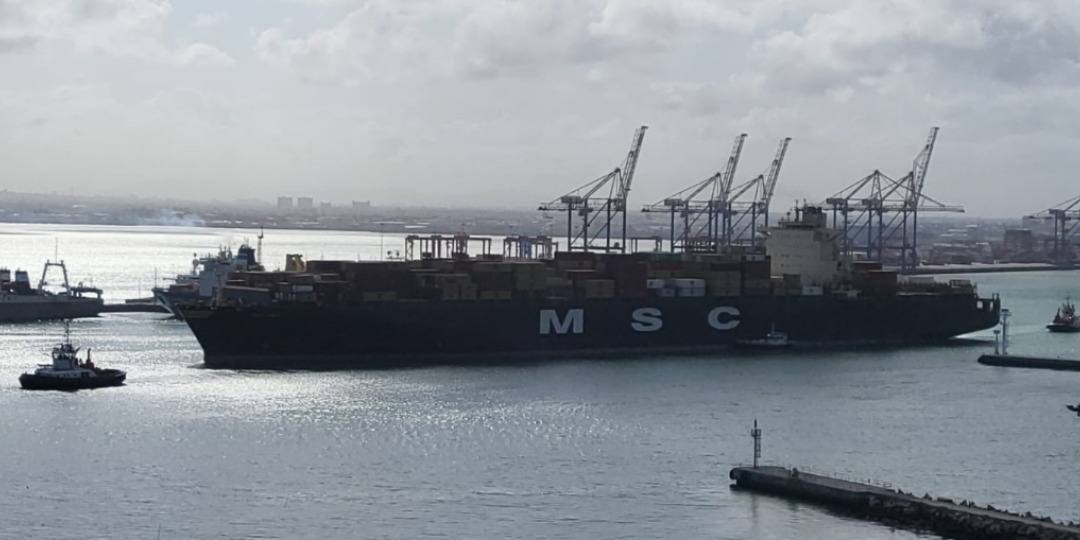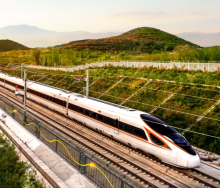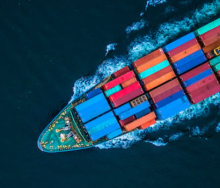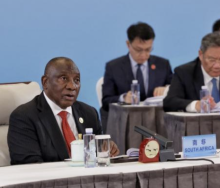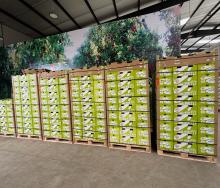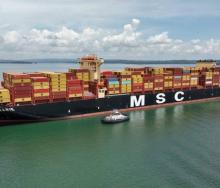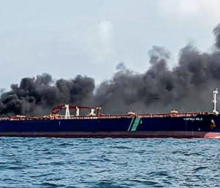The Port of Cape Town has attained a new milestone by handling the lengthiest vessel ever to call at the Cape Town Container Terminal (CTCT), the 348.5-metre-long MSC Ines.
The port’s previous ‘length overall restrictions’ (LOA) record was 336m.
According to MSC director of operations, Captain Ian Rosario, the historic port call was “made possible by the able direction of the harbourmaster, Captain Alex Miya, and his deputy, Captain Marcus Rammutloa”.
“The vessel was piloted by Captain Mthunzi Bota.”
Rosario added that it was also important to acknowledge Cape Town port manager Rajesh Dana; the Acting CEO of Transnet National Ports Authority, Advocate Phyllis Difeto; Transnet Port Terminals (TPT) managing executive, Oscar Borcherds; and TPT chief executive, Jaby Mdaki.
He said five ship-to-shore gantry cranes had been deployed to turn the vessel in record time.
“Achieving such milestones deserves recognition and applause, as these are significant incremental steps in bridging the gap of expectations and staying competitive, failing which the ships may seek alternative neighbouring ports that are gearing up and presenting no limitations.”
Rosario added: “Ships are continually evolving, with increased capacities and larger overall dimensions, owing to the surge in global demand and economies of scale. Essentially, the ports that can handle such traffic will eventually thrive.”
For the Port of Cape Town to reset its credible position in the geopolitical and geoeconomic context, and for such an achievement to be recognised, were critical to South Africa’s progression, said Rosario.
He added that many would remember the MSC Ines for the wrong reason, being the vessel that broke loose of her moorings, drifted involuntarily, and blocked the entrance of the Port of Durban during the massive storm of 10 October 2017.
All the more reason to give recognition to the different roles played by all in successfully navigating the Ines into the Port of Cape Town.

For shipping lines to be flexible with the deployment of vessels, the requirement to dock lengthier container vessels at CTCT had long been on the cards, Rosario said.
“To this effect, MSC, in alliance with the senior pilots of Cape Town, executed a simulation of the larger vessels on the bridge-simulators at the Cape Peninsula University of Technology campus.
“Numerous rounds were conducted at diverse weather and sea conditions. The shipping fraternity stands to gain significantly from this valuable study conducted by MSC that has eventually taken traction.”
However, it’s a well-known fact that, as vessels get larger, ports and man-made waterways are increasingly lagging in their capacity to accommodate floating behemoths.
A case in point is the ultra-large container vessel, Ever Given, which ran aground in the southern channel of the Suez Canal in March 2023, obstructing east-west vessel traffic for more than a week.
The necessity of port improvements to accommodate larger vessels has also been discussed by Captain Salvatore Sarno, the chairman of the Mediterranean Shipping Company in South Africa.
In respect of the Port of Cape Town, Rosario said: “A tangible solution to accommodate larger vessels would be to widen the inner breakwater entrance, preferably by removing the portion of the southern breakwater wall.
“With the suggestion of widening of the inner breakwater, there were concerns raised by the Council for Scientific and Industrial Research of the wave action – especially during the winter months – whereby the vessels are prone to surging.
“These apprehensions remain unverified pending a comprehensive study.”
He said by removing the portion of the inner breakwater, the effect of the wave action might well be subdued as opening the mouth could possibly allow an unrestrained flow of the water mass without entrapment.
“The concrete block of the inner breakwater is so constructed that it is movable, which, in essence, allows for a real-time study to be carried out without entailing reconstruction or demolition. Having dealt with the inner breakwater entrance, the turning basin would continue to remain a bone of contention with no resolve. Under the circumstances, these challenges can be addressed by redesigning the traditional manoeuvring strategy with the deployment of better-powered tugs.”
Rosario said it was worth noting that, after the quay wall at CTCT had been extended by 10 metres to deepen the berths to 15.5 metres, the vessels had experienced surging, as the extended portion was supported on stilts, which allowed access to the water mass under the quay, the main reason for surging.
“In the recent past, TNPA has procured anti-surging devices in the form of shore tensioners, which have proven to be extremely effective in dampening the surge on vessels at CTCT.”
